Mead, or fermented honey wine, is a delicious ancient fermented beverage that is easy to make! This elderberry mead, made with foraged elderberries, is a wonderful version of classic mead and perfect for the holidays.
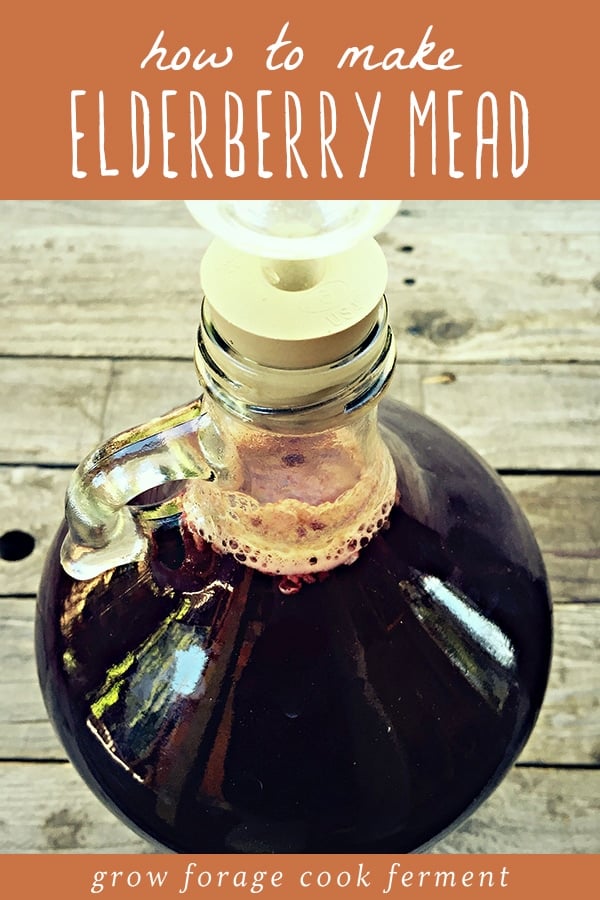
Want to save this post for later?
Simple Mead Making Ebook
Want to learn more about making mead? I have a Simple Mead Making for Beginners eBook just for you!
It has ingredient and equipment checklists and detailed instructions for brewing and bottling your mead, so be sure to check that out if you’re new to the mead making process.
Harvesting and Preparing Elderberries for Mead
Several weeks ago I came into the mother lode of elderberries, and my mind turned to one thing. Mead, of course!
For those of you who don’t know, mead is type of wine made with honey instead of sugar. Actually, when it’s made with fruit is technically called a melomel, but to keep things simple I’m just going to refer to it as mead.
Here’s how to make elderberry mead, and the first thing you will need for this recipe is elderberries, of course!
Foraging for elderberries is usually fairly easy as they are common throughout the country. You can also try growing your own elderberries!
Once you collect a bunch of elderberry clusters, you’ll need to pick the berries from the stem. This can be a bit tedious, but if you get a few people on the job it goes fairly quickly.
It’s an important step however, because the stems contain higher levels of toxic compounds than the berries. Don’t worry about the berries though, as the fermentation process takes care of any toxins that may be present.
Tip: elderberries come off the stem easier if the berry clusters are frozen first.
(You can alternatively purchase dried elderberries from Mountain Rose Herbs).
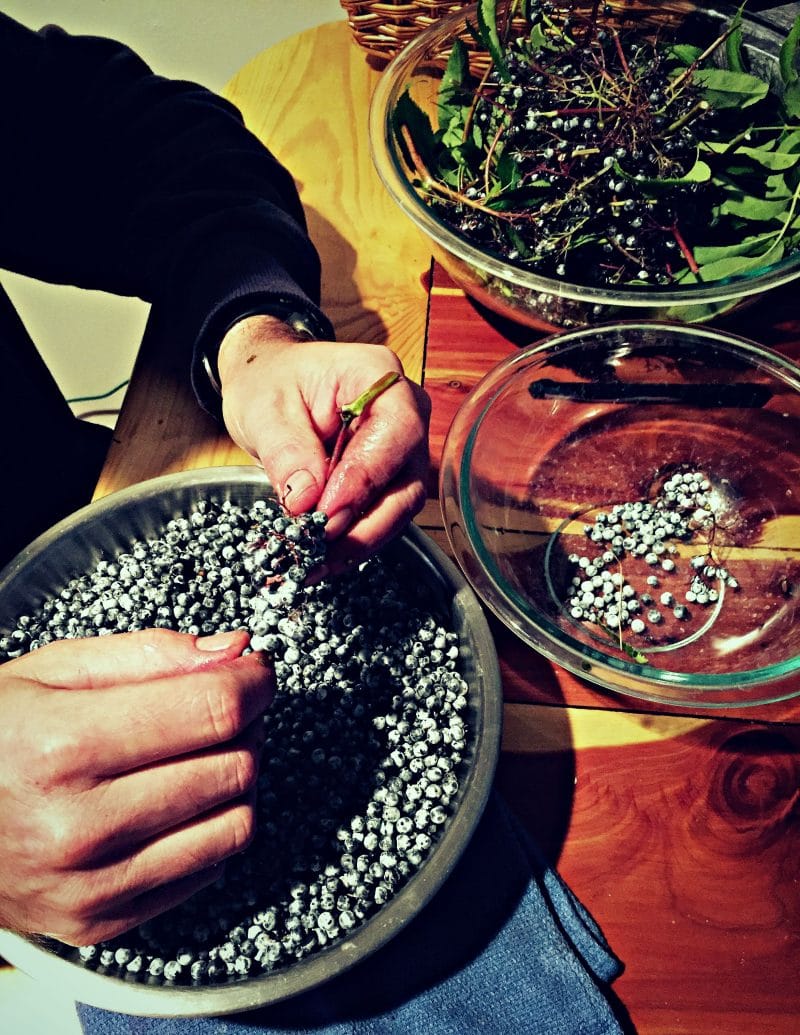
Soon you will have a nice bowl full of berries. The exact amount really doesn’t matter, as that can be variable depending on how many you can find, but several cups is a good place to start.
By the time all was said and done, we ended up with about ten cups of berries, which I turned into two gallons of mead.
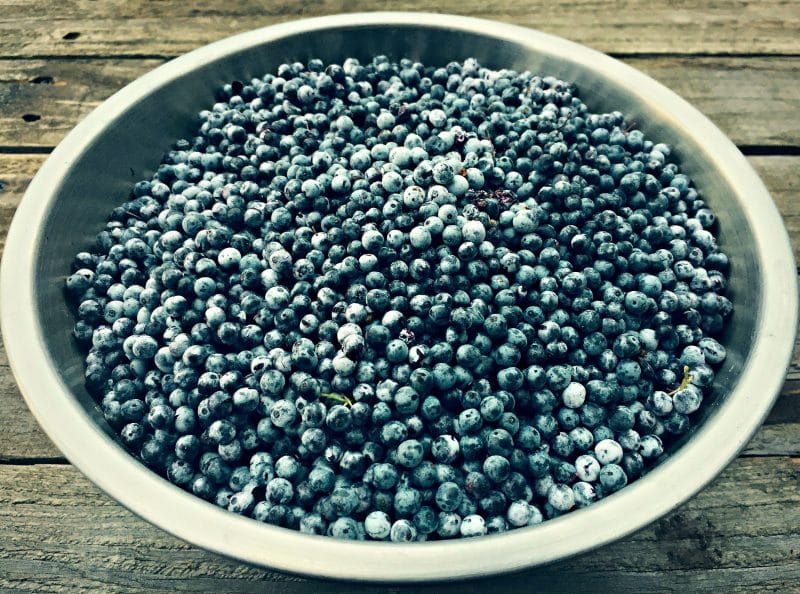
Elderberry Mead Recipe
In my past mead recipes, I’ve fermented in one gallon jugs, but for this one I decided to do an open ferment in a 3 gallon crock for the first stage.
If you don’t want to do that, you can totally make this in airlocked gallon jugs, using the same method I used in my How to Make a Gallon of Mead post, just use elderberries as the fruit.
Sanitize Everything & Mash the Elderberries
First, make sure that you sanitize the crock and anything else that you will use in the process. I usually use a product called One Step as it’s easy to use and non toxic.
After sanitizing, I put the elderberries into the crock and mashed them up a bit with a potato masher to get the juices flowing.
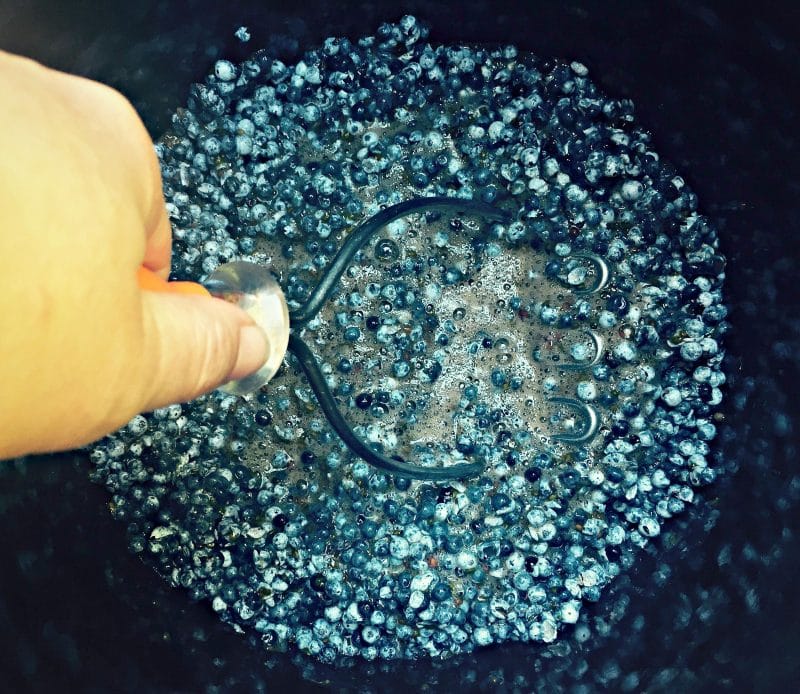
Make the “Must”
Then I added about a gallon and a half of cool, non chlorinated water, along with a cinnamon stick and a few whole cloves to the berries in the crock.
Next I poured in about five pounds of raw honey (here is a good deal on three pounds), which will result in a fairly dry mead for a two gallon batch.
Use more if you like it sweeter. Since the water is cool the honey won’t totally dissolve right away, but that’s ok.
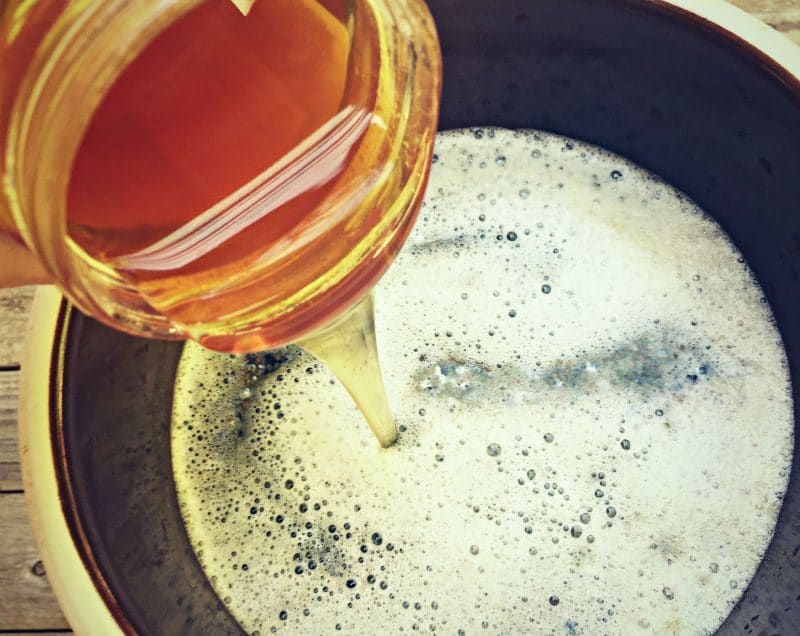
Pitch the Yeast (if you’re using it)
I went back on forth on this, but in the end I decided to use a packet of cuvee yeast for this mead (you could also use champagne yeast).
Since blue elderberries have a nice bloom on them and raw honey ferments well on its own, you could probably do this as a wild ferment (with no added yeast).
I definitely want to try this as a wild ferment someday, but with all the labor that went into collecting and picking the elderberries, along with the cost of the honey, I really wanted to make sure this mead turned out ok.
Wild yeasts can produce unpredictable results, so I chose to use added yeast for this batch.
Be aware that cuvee yeast produces an extremely dry end product, so if you’re looking for some sweetness you’ll either need to add more honey or use a sweet wine yeast.
Sprinkle the yeast on top of elderberry mixture.
You really don’t need to stir it as the yeast actually likes a bit of oxygen from the surface at first, then will eventually sink down.
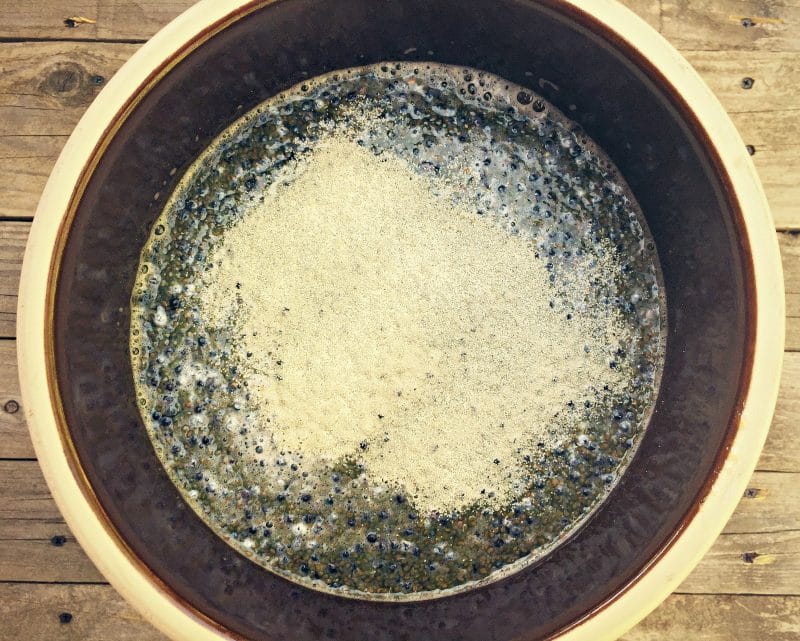
Cover for the Primary Ferment
Cover the crock with a towel and put in quiet corner of your house. By the next day you should see some bubbling action.
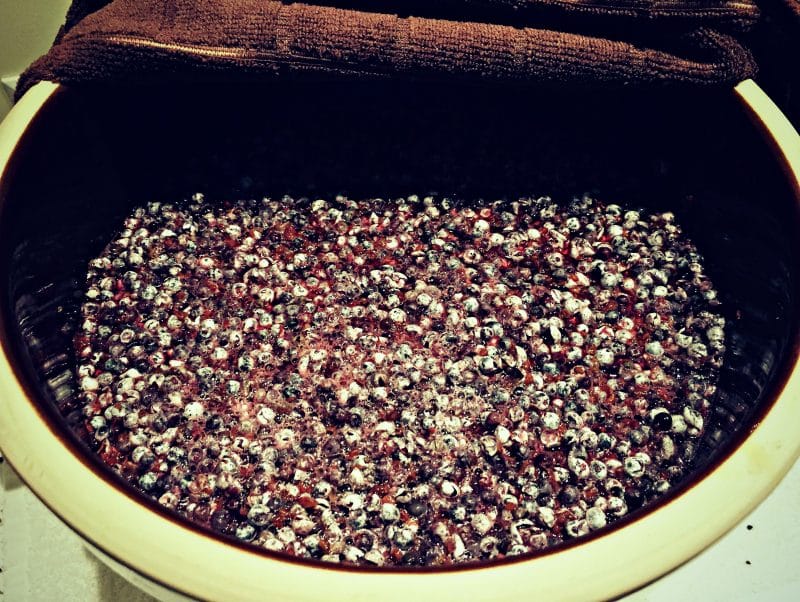
The bubbles actually made the berries start to rise up above the surface of the liquid, so I used a clean spoon to stir them down about once per day.
Soon you could really tell that the liquid had soaked up all elderberry juices and was starting to turn a gorgeous deep purple color.

Rack the Elderberry Mead into Jugs
After about a week, when the bubbles start to slow down just a bit, but are still going strong, you should rack the mead off of the berries into gallon glass jugs with airlocks.
When you use a yeast packet, that yeast will outcompete any wild yeasts that may be around.
Once the yeast starts to slow down, however, wild yeasts can start to take over and you could end up with elderberry vinegar on your hands. May not be a bad thing, but that’s not what we’re going for here!
So you’ll want to finish out the fermentation in (sanitized!) airlocked jugs. Use an auto siphon (the mini one works great) to transfer the liquid into gallon jugs.
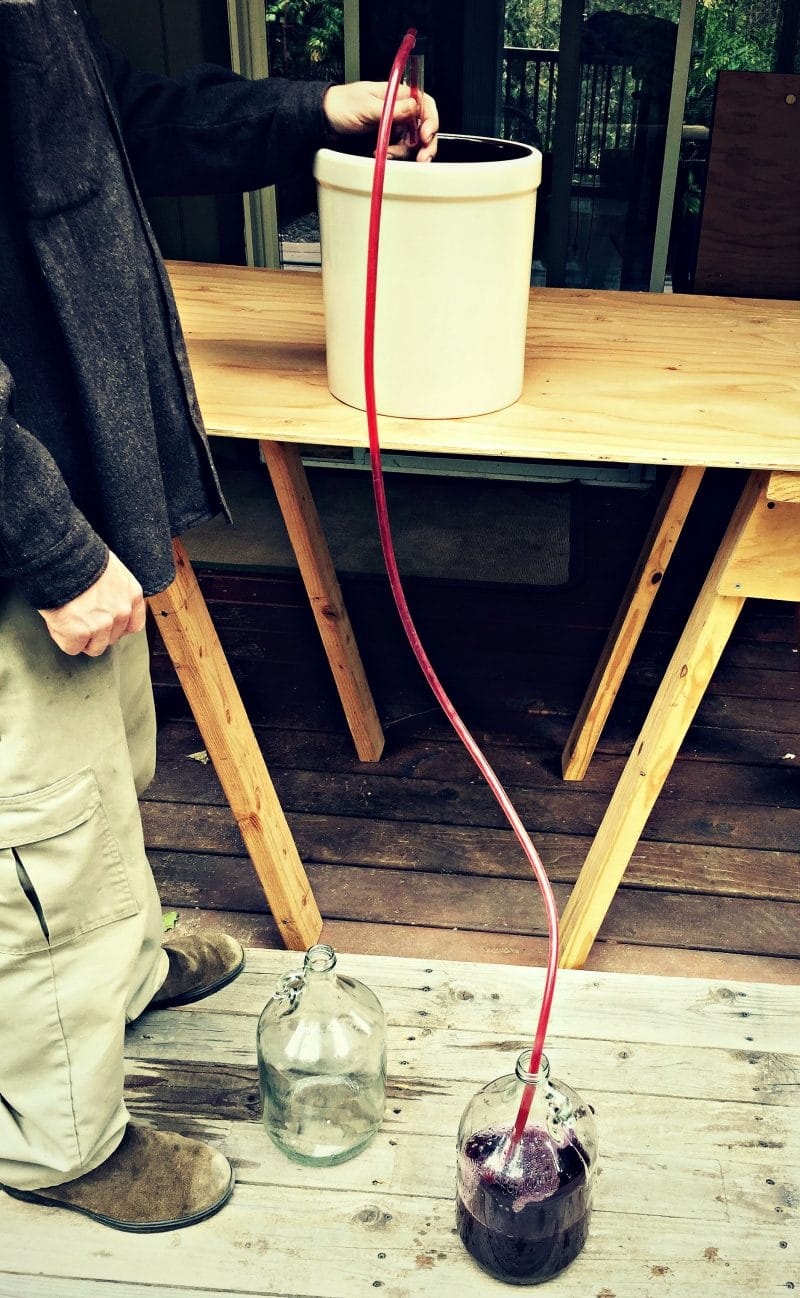
Look at how deep, dark purple it is!
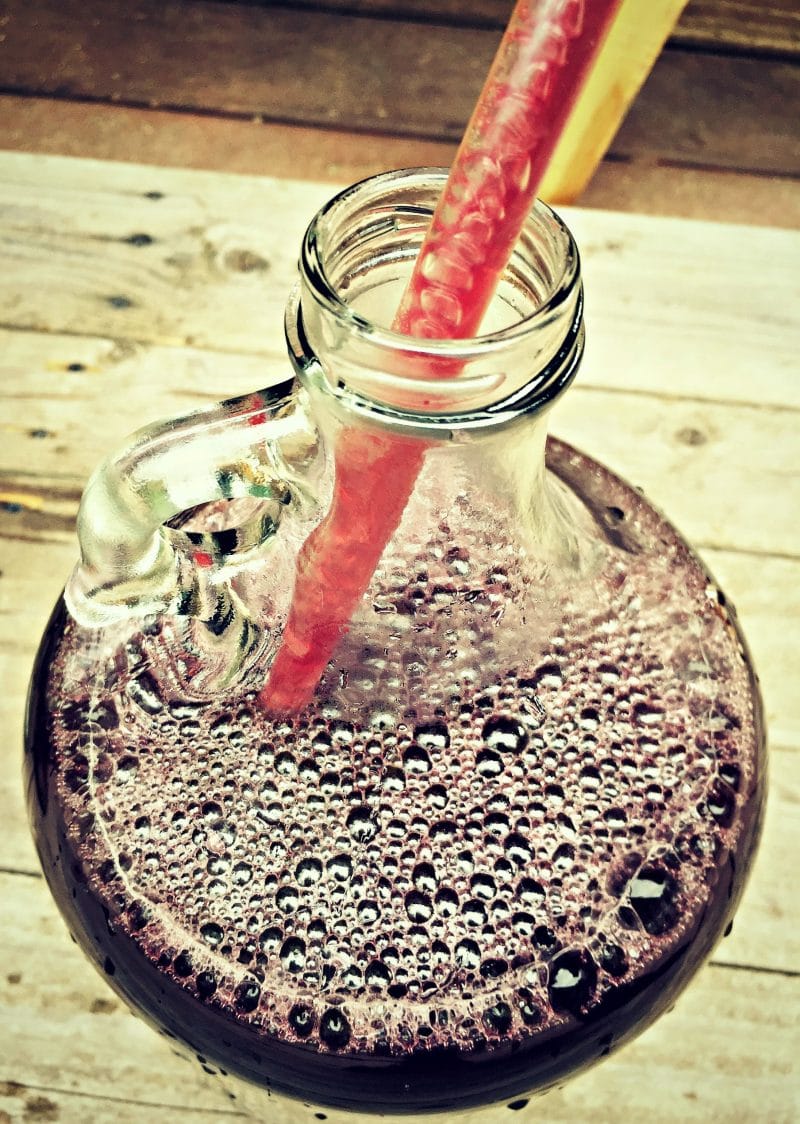
Due to evaporation, I ended up with slightly less than two gallons, which is actually what I was aiming for. How I achieved this feat I’ll never know.
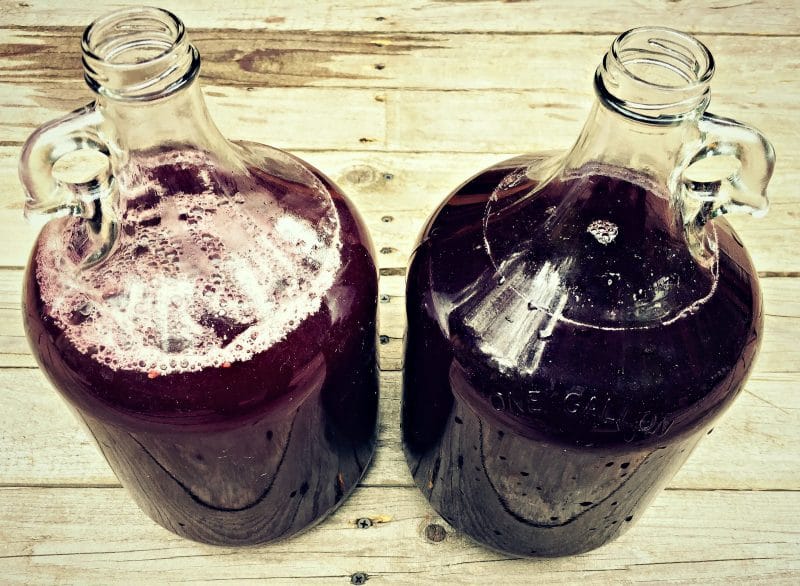
Equal out the levels of mead, then add more honey water to top it off. This will help to reinvigorate the yeast and give them a little more to chew on.
Then fill the airlocks with a little water to the line, and put them into the jugs.
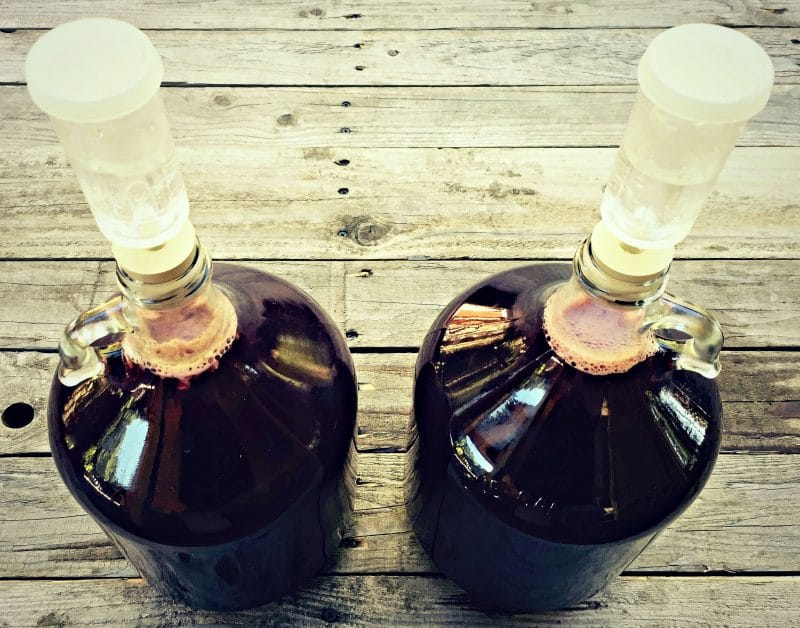
They should start bubbling away again pretty quickly. Let this go for several weeks until all signs of bubbling has stopped.
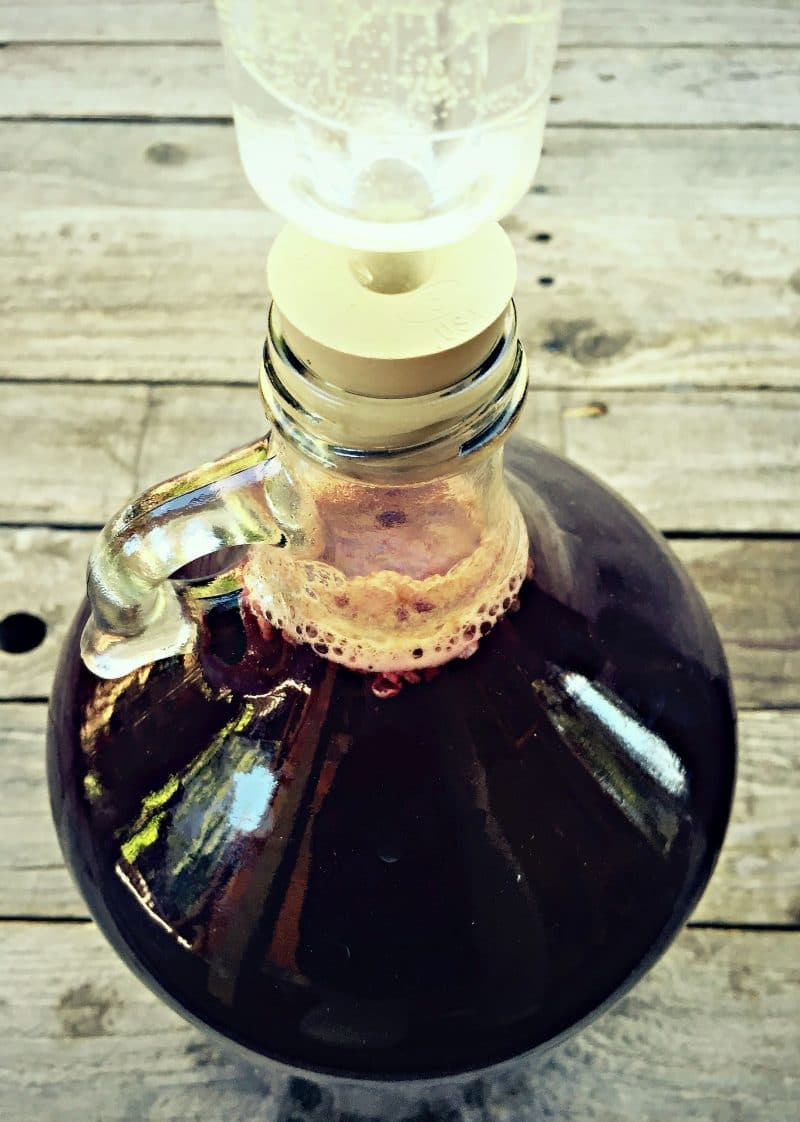
Bottle and Age the Elderberry Mead
Once the bubbling has completely stopped, you can bottle it using the same method I used for bottling hard cider, or use wine bottles and a corking tool.
I tasted a bit when we were racking it and it was actually quite nice, more like a dry red wine than anything else. It is best to let it age for at least a few months if not longer, as it will mellow out quite a bit with aging.
It will make a great drink for the holidays, that’s for sure! Mulled elderberry mead, anyone?
This is what it’s all about guys… foraging for your own food, then turning it into wine!
More Mead Recipes
Ready to start brewing your next batch of mead? Here are 15 mead recipes for you to try including:
More Elderberry Recipes
Still have more elderberries to use? Try some of these recipes, or see my post on 30+ Elderberry Recipes & Remedies for Food & Health.
- Fermented Elderberry Honey
- Elderberry Soda
- Immune Boosting Herbal Tea Blend
- Elderberry Syrup
- Elderberry Cocktail
- Elderberry Kombucha
Elderberry Mead
Equipment
Ingredients
- 10 cups fresh elderberries or 5 cups dried elderberries
- 1 ½ gallons non-chlorinated water
- 1 cinnamon stick
- 3 whole cloves
- 5 pounds raw honey more or less as desired
- 1 packet cuvee or champagne yeast optional
Instructions
- Sanitize all of your tools and supplies you will be using to make this mead.
- Put the elderberries into the crock and mashed them up a bit with a potato masher to get the juices flowing.
- Add about a gallon and a half of cool water, along with a cinnamon stick and a few whole cloves to the berries in the crock.
- Pour in five pounds of raw honey. Since the water is cool the honey won’t totally dissolve right away, but that’s ok.
- Sprinkle the yeast on top of elderberry mixture. (Stirring isn’t necessary.)
- Cover the crock with a towel and put in quiet corner of your house. By the next day you should see some bubbling action.
- Stir the berries down once a day.
- After about a week, when the bubbles start to slow down just a bit, but are still going strong, rack the mead off of the berries into gallon glass jugs with airlocks. Use an auto siphon to transfer the liquid into gallon jugs.
- Equal out the levels of mead, then add more honey water to top it off. This will help to reinvigorate the yeast and give them a little more to chew on. Then fill the airlocks with a little water to the line, and put them into the jugs. They should start bubbling away again pretty quickly. Let this go for several weeks until all signs of bubbling has stopped.
- Once the bubbling has completely stopped, you can bottle the elderberry mead and age it for several months.
Notes
- Tip: elderberries come off the stem easier if the berry clusters are frozen first.
- You can use dried elderberries if fresh aren’t available, just rehydrate them in some water first.
- If you don’t want to do the primary ferment in a crock, you can make this in airlocked gallon jugs, using the same method I used in my How to Make a Gallon of Mead post, just use elderberries as the fruit.
- Using 5 pounds of honey will result in a fairly dry mead for a two gallon batch. Use more if you like it sweeter.
- Be aware that cuvee yeast produces an extremely dry end product, so if you’re looking for some sweetness you’ll either need to add more honey or use a sweet wine yeast.
- Due to evaporation, I ended up with slightly less than two gallons of elderberry mead, which actually works out well for this recipe.


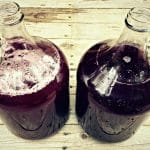

Can i add wine or champagne yeast later on? I was exited at first for the wild ferment and all is going well but reading how it can effect the flavour i thought to maybe still add a wine yeast to the batch, its been sitting for 3 days. Will it be oke? Or will that completely throw off the balance? Should i add less yeast bc the wild yeast is doing its thing?
No, it’s best to add the champagne in the beginning to kick off fermentation and influence the flavor. I’m not really sure what would happen if you added yeast later on, but you’re welcome to try!
Could I use a fermenting bucket with airlock for this recipe, instead of the open air method?
Yup!
Is there a reason for initially adding boiling water to the elderberries. I’ve seen this in other elderberry wine/mead recipes.
Hi Brenda. Elderberries lose their toxicity when cooked or fermented. Some folks prefer heating them prior to fermenting just to be sure they’ve completely neutralized any toxicity.
Will heating them remove their good properties also?
Nope!
My elderberry mead turned out so well. I also made the strawberry lemon balm mead, and have gotten so many compliments on it.
Hi Kassie! I’m so happy your mead turned out well. Enjoy!
Pro tip – after you remove the elderberry clusters from the freezer, they’re easily stripped from the stems by using a fork.
I just bottled two different batches of mead today (dandelion and elderberry), and realized that both are extremely dry for my taste. Can I add more honey now, to sweeten them?
Hi Beth. Yes, you can back sweeten your mead. Here’s a good post on how to back sweeten.
I plan to make elderberry and also a hawthorn mead. In all your recipes I noticed there isn’t a step where you strain out the berries used. Does the siphoning process take care of that? Or when would you strain out the berries? Thank you!
Hi Kelly. Yes, in step #8 in the recipe I state, “Rack the mead off of the berries into gallon glass jugs with airlocks”. That means using an auto-siphon to pull all the liquid on top of your berries and sediment out of the crock and into another vessel.
I run my elderberries in a food grinder then i add all ingredents and i add a candam tablet per gal and wait 24 hours before adding the yeast wild yeast will give a off flavour
I noticed with the simple mead you add oranges and raisins but Why don’t you add those two when you make the crock elderberry mead ?
Also number 9 in the recipe what do you mean to equal out the level of the mead?
Thank you
I’m becoming super frustrated; not with this recipe – it sounds and smells incredible!! But ive tried to make three batches of mead, now, and all three have failed to ferment. The first two I tried without wine yeast, just the honey, water and herbs, plus raisins and the last batch I added some wine yeast. But here I am four days in and NOTHING is happening.. what the heck am I doing wrong?
Hi Jenn, it’s hard for me to say without seeing your ingredients and process from start to finish. Making mead with wild yeast can sometimes be difficult. The Red Star champagne yeast I recommend always works well for me. Sometimes it does take several days for fermentation to really begin.
I’ve used elderberry syrup recently to make mead and it turned out great. Added in secondary. Very delicious.
Yum, that sounds great!
Can I use elderberry syrup in place of the elderberries?
I’ve never done it, so I can’t say if that’ll work. You would have to use quite a bit of syrup to achieve an elderberry flavor. Your best bet might be to buy dried elderberries. Mountain Rose Herbs is my favorite source for organic dried elderberries.
I recently made a gallon of elderberry mead with 2 cups of dried elderberries and 6 cups of water, rehydrated for 20 minutes in an instant pot, then strained them with a meshed screen strainer. After 2 months, the mead is still a very deep purple (not even beginning to clear), and I believe it’s going to need a lot of back sweetening with more honey for some sweetness before I can think aobut bottling.
Who put fish oil in my melomel. Thawed 3 lb. elderberries from my yard. Treated with potasium metabisulfite for 24 hrs. Added 1.5 gal filtered water and 5 lb honey. Added yeast. Fed 3x with fermaid k yeast nutrient. After one week transferred to glass jugs. A nasty fishy smelling ring of oily residue was left in my fermenting bucket. Is this normal? Melomel tastes fine.
Thanks for the inspiration!
Hi Arlen, I’ve never had my mead or melomel smell like fish, so I’m not sure what happened. I also never use yeast nutrient, so maybe that’s it?
Yeast nutrient will not leave an oily residue or smell.
One needs to be aware when talking about gallons whether that is an American
Or Imperial gallon as there is a 700mls (0.7 litre ) difference in volume.
As fermentation proceeds the volume of liquid will reduce up to 330mls per kilogram of sugar added as about half is turned into alcohol and half into CO2 which dissipates into the air.
Elderberries are said to be bad for you if consumed raw. That’s why they are made into jellies etc. Does the fermenting process eliminate the issue?
Yes, it does!
I thought elderberries were poisonous if not cooked first. I’ve read that and listened on other you tubes
The fermentation process destroys the toxicity of elderberries and renders them edible.
I started my first ever batch of dandelion Meade. Still waiting for my bubbling to stop. I am so excited. I have wild Wax Currants and also Choke Cherries. I really don’t know how many cups of fruit to use. The wax currant are very mild. My local brew shop said 4 pounds per gallon. If i am leaving the fruit in the must I won’t have as much end product and would you recommend mashing or leaving them whole? When using cherries do they need to be pitted?
New Meade Mainiac
Hi Barbara, I usually use around 1-2 cups of fruit per gallon of mead, but you can use more or less. I would probably pit the cherries before using them in mead.
a little hint on pulling the berries; if you will put the heads in a bag and freeze then take out and give the bag a good shake most of the berries will fall off in bag and the rest are easier to pick off. and often times berries will produce more juice if frozen first.
Thanks for the tip!
What do they taste like? Never had. They look like blueberries!